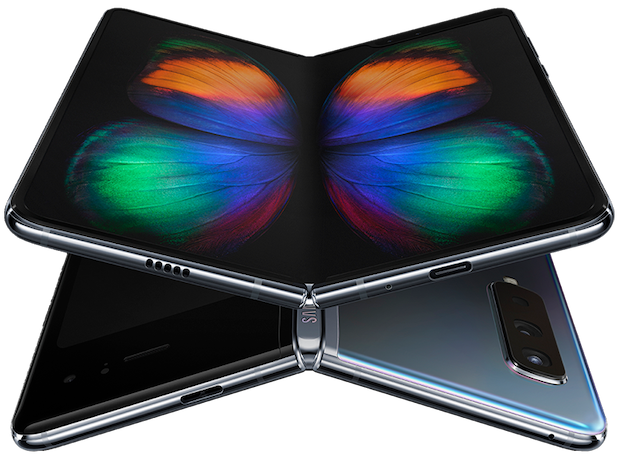One Galaxy Fold screen issue is unfixable, and you can blame physics

Like almost everyone on the planet, I've never touched a Galaxy Fold. But I have bent things made of plastic plenty of times and can see a big issue with the phone that few people are talking about: physics. Specifically, the tighter the radius of a bend in a piece of rigid or semi-rigid material, the higher the chance is that it will be damaged. Multiply that chance by the 200,000 times a Galaxy Fold screen is designed to be folded and unfolded, and there may be a big problem that can't ever be fixed.
Everything will break when bent enough times. Hopefully, enough only happens after the end of useful product life.
I'm not crazy, as it is obvious that Samsung has already considered the issue. A quick look at the hinge of the device when it is folded shows it. That decidedly unsexy gap at the hinge is there specifically to combat the problem. Folding it tightly when closed would exacerbate it and lead to a much more prominent crease a lot sooner than expected or, worse, causes premature screen failure.
You don't have to make phones to figure that out, either. Just take a rigid screen protector made for any regular phone and bend it. Admire the perma-crease you just created, then bend it a few hundred times until it tears. Plastic can be a wonderfully tough material in a phone, but it will eventually be damaged.
At first glance, the display on the Fold looks like any other Samsung phone. It's big and beautiful, has that distinct AMOLED color pattern, and makes you want to pick it up and use it. Samsung is the king of small form-factor display technology for a good reason and the company knows how to do it better than anyone else. But it's also a screen that's designed to fold, which is a whole new idea.
That idea means plenty of plastic. Hard plastic, soft plastic — even secret plastics. Anyone who has ever taken a phone apart knows just how fragile the actual display is once you get rid of the glass, and the OLED panel in the Fold is no different. The OLED layer itself along with the digitizer — the piece that registers when you've touched it — will break and tear at the slightest disturbance.
Samsung not only had to reinvent the phone form factor with the Fold, it had to reinvent some display tech, too.
These need to be sandwiched between layers of flexible material that will allow for the Fold to bend and stay rigid enough to prevent damage at the same time. The tighter the radius of that fold, the better the chance this rigid layer will become creased forever or even break. And you only need to look towards China to see that there might be a better way.

The initial reaction to the Huawei Mate X was that the display should fold over itself the way Samsung is doing it — an innie rather than an outtie. It would arguably look better, but more importantly, it would protect the display more so than having it exposed. After seeing how quickly the crease has become more prominent on several reviewers' Galaxy Fold units, and other issues surrounding the display, I think the opposite may be true.
Get the latest news from Android Central, your trusted companion in the world of Android
The Mate X may look worse when folded, but I'll bet it lasts a lot longer.
Having a much larger radius in the folding area of the display, as seen in the Mate X, probably makes for a much tougher panel that's far less prone to damage at the crease. Tougher materials can be used that are more rigid because the spot where a crease can form is non-existent. Tough, stiffer plastics mean a tougher exterior layer that can fend off more scratches and abuse.
That's important because as Samsung reminds us, you can't add any sort of adhesives or other layers atop the Fold display aside from the existing plastic protector. That means no additional screen protectors, at least for now.

In the bigger scheme of thing none of this matters. The Galaxy Fold is a first generation product that's only going to be purchased by enthusiasts who are willing to send damaged units back to Samsung for repair or replacement. The ungainly looks and $2,000 price means there won't be any real consumer demand for the product, and Samsung is free to keep working at the idea until a consumer-ready version can be built and sold.
Samsung has a track record of perfecting a product category. The Fold will be the same.
That's an idea Samsung is familiar with and has perfected. Looking back, can anyone say the original Galaxy Note was a failure? It was expensive, very few were sold, and it needed several versions of refinement to turn into the mainstream success the Note line has become.
Give the Fold a couple of versions, and it may turn out the same.

A remarkable engineering achievement
Samsung's newest phone is actually a tablet in disguise, but it pulls off both. That's the beauty of being the first in a new category, since some of the Fold's flaws, along with its high price, can be forgiven. Still, only early adopters should consider the Galaxy Fold right now.

Jerry is an amateur woodworker and struggling shade tree mechanic. There's nothing he can't take apart, but many things he can't reassemble. You'll find him writing and speaking his loud opinion on Android Central and occasionally on Threads.
